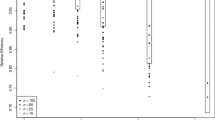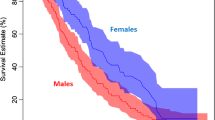Summary
A linear regression method that allows survival rates to vary from stage to stage is described for the analysis of stage-frequency data. It has advantages over previously suggested methods since the calculations are not iterative, and it is not necessary to have independent estimates of stage durations, numbers entering stages, or the rate of entry to stage 1. Simulation is proposed to determine standard errors for estimates of population parameters, and to assess the goodness of fit of models.
Similar content being viewed by others
References
Ashford, J. R., K. L. Q. Read, andG. G. Vickers (1970) A system of stochastic models applicable to animal population dynamics.J. Anim. Ecol. 39: 29–50.
Bellows, T. S. andM. H. Birley (1981) Estimating developmental and mortality rates and stage recruitment from insect stage-frequency data.Res. Popul. Ecol. 23: 232–244.
Birley, M. (1977) The estimation of insect density and instar survivorship functions from census data.J. Anim. Ecol. 46: 497–510.
Dempster, J. P. (1961) The analysis of data obtained by regular sampling of an insect population.J. Anim. Ecol. 30: 429–432.
Kempton, R. A. (1979) Statistical analysis of frequency data obtained from sampling an insect population grouped by stages. 401–418. InJ. K. Ord, G. P. Patil andC. Taillie (eds)Statistical Distributions in Scientific Work. International Cooperative Publ. House, Maryland.
Kobayashi, S. (1968) Estimation of the individual number entering each development stage in an insect population.Res. Popul. Ecol. 10: 40–44.
Lakhani, K. H. andM. W. Service (1974) Estimating mortalities of the immature stages ofAedes cantans (Mg.) (Diptera, Culicidae) in a natural habitat.Bull. Entomol. Res. 64: 265–276.
Mills, N. J. (1981a) The estimation of mean duration from stage frequency data.Oecologia 51: 206–211.
Mills, N. J. (1981b) The estimation of recruitment from stage frequency data.Oecologia 51: 212–216.
Read, K. L. Q. andJ. R. Ashford (1968) A system of models for the life cycle of a biological organism.Biometrika 55: 211–221.
Richards, O. W., N. Waloff, andJ. P. Spradbery (1960) The measurement of mortality in an insect population in which recruitment and mortality widely overlap.Oikos 11: 306–310.
Southwood, T. R. E. andW. F. Jepson (1962) Studies on the populations ofOscinella frit L. (Dipt.: Chloropidae) in the oat crop.J. Anim. Ecol. 31: 481–495.
Straalen, N. M. van (1982) Demographic analysis of arthropod populations using a continuous stagevariable.J. Anim. Ecol. 51: 769–783.
Straalen, N. M. van (1985) Comparative demography of forest floor Collembola populations.Oikos 45: 253–265.
Author information
Authors and Affiliations
Rights and permissions
About this article
Cite this article
Manly, B.F.J. A multiple regression method for analysing stage-frequency data. Res Popul Ecol 29, 119–127 (1987). https://doi.org/10.1007/BF02515430
Issue Date:
DOI: https://doi.org/10.1007/BF02515430




